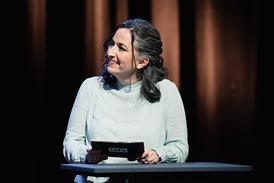The Twilight director talks about her latest project, a gothic fairytale backed by Leonardo DiCaprio’s production house Appian Way and Warners Bros
Catherine Hardwicke was a much sought-after production designer when she burst on the directing scene with her searing vision of teen life in LA, 13. Hardwicke followed up with The Lords Of Dog Town and then last year entered the history books with Twilight, the highest-grossing film directed by a woman. Her next project, The Girl With The Red Riding Hood, goes to camera in the summer, backed by Leonardo DiCario’s production house Appian Way and Warner Bros. She spoke with Denis Seguin in advance of her appearance at Toronto’s Female Eye Film Festival where she will be the first foreign recipient of the Female Eye Honourary Director Award.
What does Kathryn Bigelow’s win mean for female directors?
Hardwicke: It’s got to help. There’s still this idea that women don’t direct action films, that women don’t do fight scenes. And yet Kathryn has been doing it for years. I had that same problem on Twilight. I saw so much potential beyond making this a one-quadrant movie aimed at what people think girls like.
Girls like action, but it has to relate to the characters, it has to be interesting. I brought in storyboards and illustrations and really sold them on the idea of taking the picture beyond the book, to put in the fight scenes and the flight through the tree tops. After we did a family-and-friends test screening, I realized there were all these details that the book’s fan base, which was growing and growing, really cared about. And I was able to convince the producers to let me shoot additional scenes that could build on that.
People were surprised you didn’t direct the second film in the franchise, New Moon. What happened?
Hardwicke: It was in my contract: if Twilight made one and a half times what it cost to make I had first right of refusal to do the next film. But I never wanted to. Even when I was a production designer I never went to an interview if the movie was a sequel. I’d rather do the first in a series. I like something that’s fresh and original, something I haven’t seen before. Sometimes when the second and third ones come out they lose a little bit of that excitement.
I said the only way it could work is if I had time to dream up some cool stuff that made me want to do it, that made me believe I could do it better than I did the first one. But they did not want to wait. Summit wanted to maintain the same release schedule and come out a year later. Obviously it worked out for them, they made a ton of money. I have another project with Summit too, so we’re all buddies. But I didn’t think [New Moon] was for me. And I’m so glad I didn’t.
What’s your take on the independent distributors like Summit? They seem to be breathing life into the business.
Hardwicke: Absolutely. Summit is amazing. Obviously Rob Friedman has had a long career at the studios, most recently at Paramount. He knows the studios inside and out and so does his head of marketing, Nancy Kirkpatrick. And you can see they use all that expertise to be very competitive, if not blow away the studios. In the case of Twilight, that was a really big success with a small outlay. We made it for $37m and we made more on our opening weekend than any James Bond movie has ever made in the US.
Now you are working with Leonardo DiCaprio’s company and Warner Bros. on The Girl In The Red Riding Hood…
Hardwicke: Leonardo has this idea of a reinvention of the fairytale. I read the first draft by David Leslie Johnson and loved it. I’ve worked for about five months with him and then a second writer, Rand Ravich, and now we’re back with David. We’re making it a wild thriller in this great Gothic fairytale world, very sexy, romantic and scary. I get to create a whole world. Obviously, I love the Twilight world, it was why I wanted to do it, I had never seen pale, beautiful vampires in the Pacific Northwest, that green lush environment. But still the kids had to wear clothes that would fit into high school. So it was pretty traditional and present-day. This new project lets me go back to how I started: art, architecture and animation.
You are actually a certified architect. I’m trying to think of any other film-maker who started as an architect.
Hardwicke: I built over 120 buildings between [age] 21 and 23. And then I decided that people are too conservative with their architecture. They want their buildings to look like everyone else’s and they are worried about resale value. I wanted to do something more creative. At that time I thought the film business encouraged creativity. So I moved to LA and went to grad school at UCLA for a year. And then I worked in animation for a few years and made some short films. And then people said, ‘Hey, you’re an architect, why don’t you do the art direction or production design on a movie?’ And that’s how I started making a living and I loved it. I got to work on some great films. A lot of great directors started as art directors, like Alfred Hitchcock and James Cameron. And of course Ridley Scott has a deep background in art. But maybe you’re right, maybe there is no other director with an architectural degree.































No comments yet